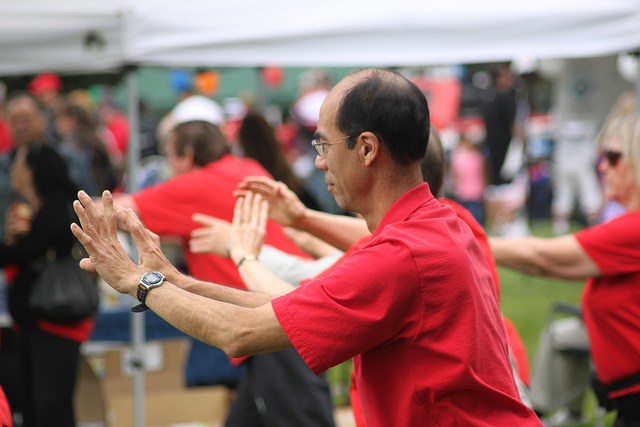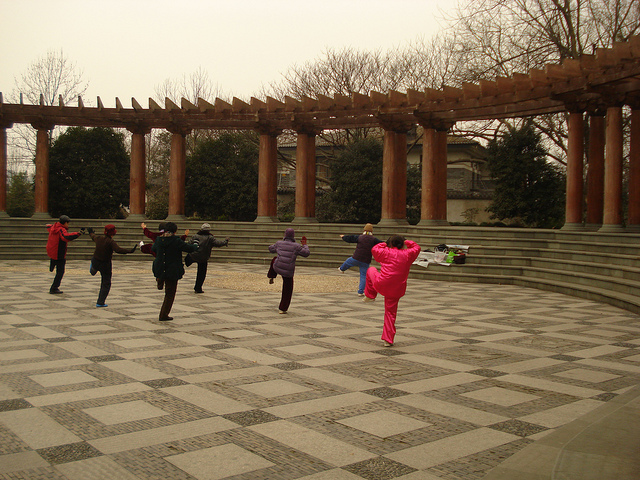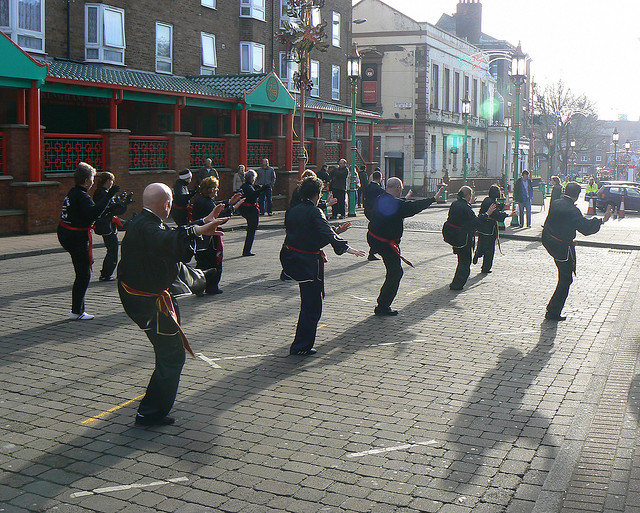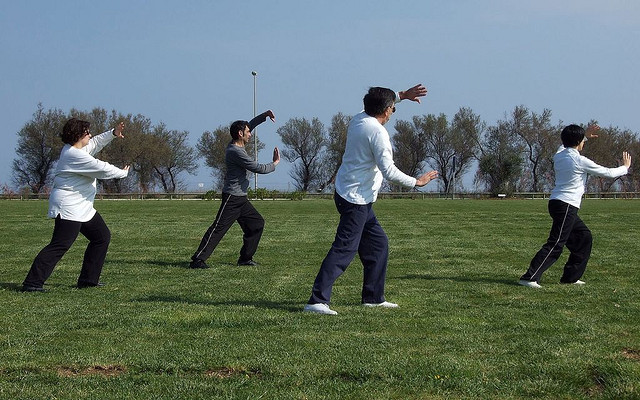
If you’re looking for a way to reduce stress, consider Tai Chi. Originally developed as a form of self-defence, Tai Chi has evolved into a graceful form of exercise that’s now used for stress reduction and a variety of other health conditions. Tai Chi is an ancient Chinese tradition with influences that go back to Taoist and Buddhist monasteries in the 12th century. According to Chinese legend, the technique was created by a Taoist monk who was inspired as he watched a crane and a snake battle. Impressed by the snake’s ability to subtly and swiftly avoid the bird’s thrusts, he devised a series of self-defence techniques that do not involve force, but stresses evasion, causing the opponent’s own momentum to work against them.
What is Tai Chi?

Photo Credit: Doug Hay, Flickr
The phrase “t’ai chi ch’uan” translates to “supreme ultimate fist” or “boundless fist”, an apt way of describing the martial art itself. There are five different styles of Tai Chi, each with their own separate methods and principles. Tai Chi, is characterised by slow, graceful, continuous movements that are gentle on the joints and muscles, and is accompanied by deep breathing. Having seen a surge in interest in many parts of the world today, tai chi is best described as a moving form of yoga and meditation combined – it is a non-competitive, selfpaced system of gentle physical exercises and stretching, where the poses flow smoothly from one into another, ensuring the body is in constant motion.
Different Types of Movements in Tai Chi

Photo Credit: David Kite, Flickr
There are a number of so-called forms or sets which consist of a sequence of movements, many of which are originally derived from the martial arts. Each style may have its own subtle emphasis on various Tai Chi principles and methods. At one point, this ancient form of exercise had more than 100 separate movements or postures, but currently there are two popular versions of 18 and 37 movements respectively. Tai Chi is widely gaining popularity in the west, as many find this activity appealing mainly due to it being an inexpensive form of exercise, requiring no special equipment and can be done indoors or out, either alone or in a group. Tai Chi is low impact and puts minimal stress on muscles and joints, making it generally safe for all ages and fitness levels. For many practitioners the focus of tai chi is performing it as a meditative exercise for the body, rather than as a straight up martial art.
The Concept of ‘chi’

Photo credit: Peter, Flickr
In Chinese philosophy and medicine there exists the concept of ‘chi’, a vital force that animates the body. One of the asserted aims of Tai Chi is to foster the circulation of this ‘chi’ within the body, with the belief that by doing so the health and vitality of the person are enhanced. Another aim of Tai Chi is to foster a calm and tranquil mind, focused purely on the precise execution of these exercises. Learning to do them correctly provides an opportunity to learn about balance, alignment, motor control, rhythm of movement, and the genesis of movement from the body’s vital centre among others.
Five Essential Qualities of Tai Chi

Photo Credit: Luigi Scorcia, Flickr
While strict attention to body position is critical, proper breathing is considered to be equally important – both mental and physical balance are considered essential to Tai Chi. Altogether, the five essential qualities of Tai Chi are slowness (to develop awareness), lightness (to make movements flow), balance (to prevent body strain), calmness (to maintain continuity), and clarity (to focus the mind).
Physical and Mental Benefits of Tai Chi

Photo credit: John Picken Photography, Flickr
Tai Chi has both physical and mental benefits. If done regularly, it improves muscle tone, flexibility, balance, and coordination. The calming and meditative aspects of Tai Chi allow many to experience its ability to relieve stress. Researchers who have studied Tai Chi have reported benefits for patients who have heart disease, respiratory problems, high blood pressure, arthritis, and multiple sclerosis. Older people may improve their balance, strength, and flexibility and lessen their chance of falling.
The main elements of Tai Chi are movement, breathing, and meditation. The 4 benefits of practising Tai Chi are:
1. Fitness and flexibility
Because Tai Chi is a weight-bearing form of exercise and will use all your major muscle groups, it improves strength and endurance. Its movements also enhance
balance, agility, coordination, and flexibility.
2. Heart and respiratory health
Tai Chi is an aerobic form of exercise, which means your heart works harder and increases the flow of oxygen in your blood. Tai Chi breathing exercises increase
lung capacity and improve oxygen circulation.
3. Mental health
Research shows that meditative aspects of Tai Chi can help relieve stress, improve concentration, lower blood pressure, and reduce your heart rate.
4. Overall well-being
Tai Chi may improve your digestion and your immune system, and help you sleep better.
Have you tried Tai Chi before? What do you think of this activity? Let us know in the comment section below.
Homepage Highlight Photo credit: Armando G Alonso ✈︎ / Foter / CC BY-NC-SA
Read more:
- 7 Ways to Cope When You Are Stuck in Traffic
- 4 Fun Ways to Keep Fit
- 5 Tips to Lose Weight and Get Fit with Futsal
What are your thoughts on this article? Let us know by commenting below. No registration needed.
Source: The Expat Magazine November 2014
"ExpatGo welcomes and encourages comments, input, and divergent opinions. However, we kindly request that you use suitable language in your comments, and refrain from any sort of personal attack, hate speech, or disparaging rhetoric. Comments not in line with this are subject to removal from the site. "



















